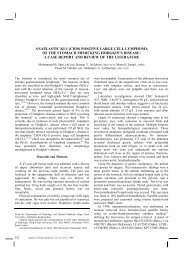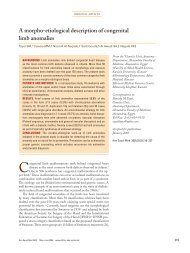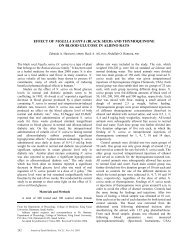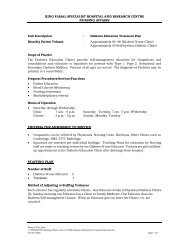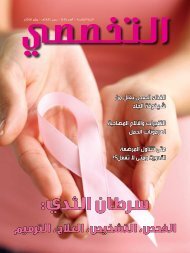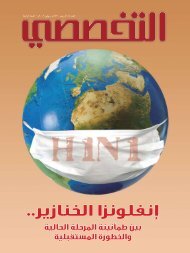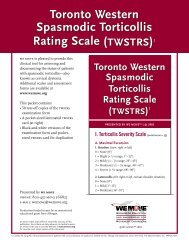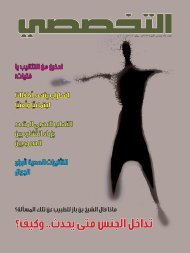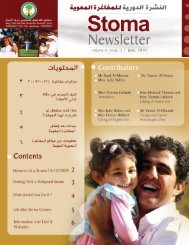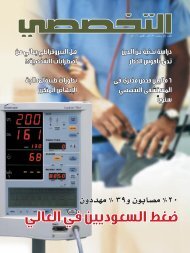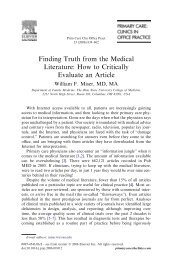THE HYMEN MORPHOLOGY IN NORMAL NEWBORN SAUDI GIRLS
THE HYMEN MORPHOLOGY IN NORMAL NEWBORN SAUDI GIRLS
THE HYMEN MORPHOLOGY IN NORMAL NEWBORN SAUDI GIRLS
You also want an ePaper? Increase the reach of your titles
YUMPU automatically turns print PDFs into web optimized ePapers that Google loves.
<strong>THE</strong> <strong>HYMEN</strong> <strong>MORPHOLOGY</strong> <strong>IN</strong> <strong>NORMAL</strong> <strong>NEWBORN</strong> <strong>SAUDI</strong> <strong>GIRLS</strong>Abdullah S. Al Herbish, FRCPC, FAAPBackground: Hymen morphology has a medico-legal importance. In view of the lack of national norms,establishing the hymen morphology of Saudi newborn infants is essential.Subjects and Methods: Over a period of 4 months, the genitalia of 345 full-term female newborn infants wereexamined to determine the shape of the hymen. A previously described labia traction technique was used toclassify the hymen morphology into annular, sleeve-like, fimbriated, crescentric, and other types.Results: The hymen was present in all 345 female newborn infants examined. A total of 207 (60%) were of theannular type, 76 (22%) were sleeve-like, 43 (12.5%) fimbriated, 17 (4.9%) crescentric, and 2 (0.6%) of othertypes.Conclusion: The most common hymen morphology in Saudi newborn girls was annular, followed by sleeve-like,fimbriated, and crescentric. This study may be the first to define normal configuration of the hymen in thiscommunity.Ann Saudi Med 2001;21(3-4):188-189.Key Words: Hymen, morphology, newborns.The morphology of the hymen has a medico-legalimportance. Pediatricians are sometimes confronted withthe challenge of documenting evidence of acute or chronicaccidental or non-accidental trauma to the hymen. Lack ofnormal standards leaves the matter open for endless andworrying uncertainty. Establishing norms for the hymenshape at various ages is, therefore, a national need. In thisstudy, the shape of the hymen was studied in 345 Saudinewborn infants in two major hospitals in Riyadh, SaudiArabia.Subjects and MethodsFor a period of four months, 345 female newborns (1-3days old full-term) born in King Khalid University Hospitaland King Fahad National Guard Hospital in Riyadh wereexamined. The examination was held in the postnatal wardimmediately after the hospital staff physician’s routineexamination had been made. The baby was placed in thesupine position on an examination table with legs flexedand held by a nurse or an assistant examiner. The mainexaminer then performed the labia traction techniquedescribed by Berenson et al. 1,2 The lower portion of thelabia majora was grasped between the thumb and the indexfinger and gently pulled outward. The examiner inspectedthe hymen to classify it into one of the following previouslydescribed hymen configurations. 1From the Department of Pediatrics, College of Medicine, King SaudUniversity, Riyadh, Saudi Arabia.Address reprint requests and correspondence to Dr. Al Herbish: P.O.Box 90533, Riyadh 11623, Saudi Arabia.Accepted for publication 5 June 2001. Received 31 January 2001.1. Annular: a hymen that surrounds the vaginal openingat 360 degrees.2. Sleeve-like: annular shape with a vertically displacedorifice.3. Fimbriated: redundant and folded with a riffled and/orfirged edge.4. Crescentric: posterior rim of hymen with attachmentat 11 and 1 o’clock position.5. Other types: these may include septated, cribriform,etc.Newborns who were admitted to intensive care unitswere excluded. A few newborns were photographed afterinformed consent was obtained from their parents.ResultsAll 345 female newborns were examined at 1 or 2 daysof age. They were all full-term deliveries, with a mean birthweight of 3.247 kg (range 2.160-4.880) and length of 49.1cm (range 44-55 cm). The hymen was present in all infants.The number and percentage of infants with the listed shapesabove was 207 annular (60%), 76 sleeve-like (22%), 43fimbriated (12.5%), 17 crescentric (4.9%), and 2 (0.6%)classified as other types.DiscussionThe hymen was present in all 345 babies presented. Thisis consistent with the series by Jenny et al., where it waspresent in all 1131 newborns examined. 3 This implies thatabsence of the hymen is an extremely rare entity inneonates. Establishment of norms for the hymen shape andconfiguration is a medical, legal and sociocultural need for188 Annals of Saudi Medicine, Vol 21, Nos 3-4, 2001
<strong>HYMEN</strong> <strong>MORPHOLOGY</strong>every community. The hymen configuration may differaccording to the racial background. The annular-shapedhymen was the most predominant type seen in this study.The sleeve-like hymen may be considered as a subtype ofthe annular shape. It may, therefore, increase the percentageof this type to almost 82%. In 1991, Berenson et al. showedsimilar findings of 80% in 468 newborn infants. 1The fimbriated-shaped hymen was present in 12.5% ofthose studied. This is a smaller figure compared to thestudies done in America. 1,4-7 This reflects racial differences,as all infants presented in this study were of Saudiparentage. The Asian group in the study by Berenson et al.was too small to be considered for comparison. 1 Thecrescentric-shaped hymen was present in only 17 (4.9%) ofthe subjects. Estrogen withdrawal at an older age mayconvert some of the annular types into this crescentricshapedconfiguration. This is especially noted among thoseneonates having a cleft at the 12 o’clock position.Reproducing our study for older Saudi infants, preferablydone in a prospective nature, may clarify this phenomenon.Estrogen abundance at the neonatal age may havecontributed to the rarity of labial agglutination, which maybe confused with labial fusion due to pathological androgenexposure due, for example, to congenital adrenalhyperplasia, which is not uncommon in this country. 8This study did not describe hymenal opening size andpresence of certain variations such as polyps, cysts, bonds,ridges and rims. These may change with age, andprospective longitudinal studies may better describe thesefindings and their evolution. 5-7Sexual abuse, although a rare occurrence in neonates,makes it vital for normal standards to be established. It isimportant, therefore, for the fundamental configuration tobe known in order to decide on the genital findings insexually abused infants and children. At an older age, the ofsuspicion of sexual abuse. In a study of 1057 prepubertalgirls aged 6 months to 10 years, Pugno defined thetranshymenal diameter to be 2.3 mm, with 1 mmincrements per year of age. 9 In a recent study by Berensonet al., 10 there was no statistical difference in the hymenmorphology of abused and non-abused prepubertal girls;the significant finding was in their histories and/or presenceof vaginal discharge.This study may be the first to define the normalconfiguration of the hymen for Saudi newborn girls. It ishoped that further similar studies at older ages may becarried out. This is important in this community whereambiguous genitalia may not be uncommon, and will alsohelp when accidental and non-accidental genital trauma issuspected. 8,9References1. Berenson A, Hegar A, Andrews S. Appearance of the hymen inNewborns Pediatrics 1991;87:458-65.2. McCann J, Vovis J, Simon M, Wells R. Comparison of genitalexamination techniques in prepubertal girls. Pediatrics 1990;85:182-7.3. Jenny C, Kuhns MLD, Arakawa F. Hymens in the newborn femaleinfants. Pediatrics 1987;80:399-400.4. Mor N, Merlob P, Reisner SH. Types of hymen in the newborninfant. Eur J Obstet Gynecol Reprod Biol 1986;22:225-8.5. Berenson AB, Hegar AH, Hayes JM, Bailey RK, Emans SJ.Appearance of the hymen in prepubertal girls. Pediatrics1992;89:387-94.6. Berenson AB. A longitudinal study of hymenal morphology in thefirst 3 years of life. Pediatrics 1995;95:490-6.7. Berenson AB. Appearance of the hymen at birth and one year of age:a longitudinal study. Pediatrics 1993;91:820-5.8. Al Jurayyan NAM, Al Herbish AS, Abo Bakr AM, et al. Congenitaladrenal hyperplasia in a referral hospital in Saudi Arabia:epidemiology, pattern and clinical presentation. Ann Saudi Med1995;15:447-50.9. Pugno PA. Genital findings in prepubertal girls evaluated for sexualabuse. A different perspective on hymenal measurements. Arch FamMed 1999;5:403-6.10. Berenson AB, Chacko MR, Wiemenn CR, Mishaw CV, FriederichWN, Grady JJ. A case control study of anatomic changes resultingfrom sexual abuse. Am J Obstet Gynecol 2000;182:820-34.Annals of Saudi Medicine, Vol 21, Nos 3-4, 2001 189



